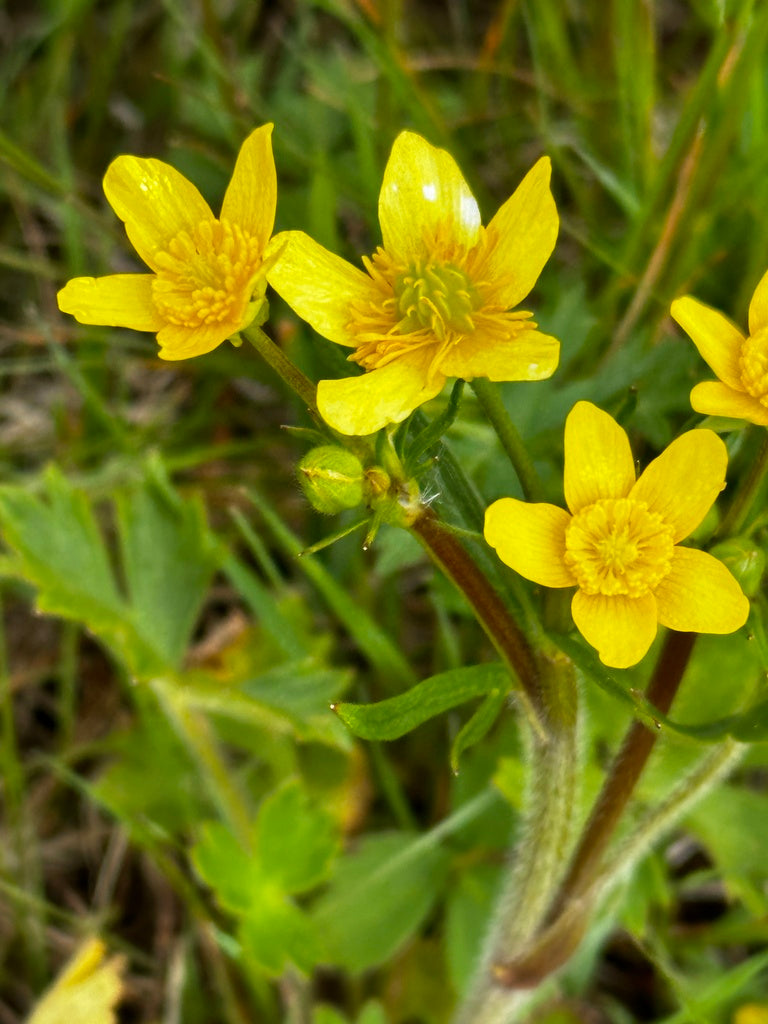Delicate, cheerful, and often found carpeting meadows and fields in golden light, the buttercup is a flower that evokes innocence and childhood nostalgia. Known for its shiny, cup-shaped blooms and bright yellow hue, the buttercup brings a sense of wild, untamed beauty to any garden.
Though simple in appearance, buttercups are surprisingly diverse and resilient. Whether you’re growing ornamental cultivars or letting wild varieties naturalize, these flowers provide a sunny presence in spring and early summer, attracting pollinators and delighting the eye.

Portrait of the Buttercup
Buttercups belong to the Ranunculus genus, which contains over 400 species. While the classic wild yellow buttercup (Ranunculus acris) is most commonly recognized, other varieties include Ranunculus asiaticus, known for its layered, rose-like flowers in shades of red, pink, orange, and white.
Most buttercups are herbaceous perennials, although some are annuals or biennials, depending on the species and climate.
- Common types: Meadow buttercup, Persian buttercup, creeping buttercup.
- Symbolism: Youth, charm, and joy.
Foliage and Form
Buttercup leaves vary by species but are typically deep green, lobed or finely cut, and can resemble parsley in texture. The foliage is often low and bushy, forming a leafy base from which flower stems rise.
- Form: Upright or spreading, with slender, branching stems.
- Height: 20–45 cm (8–18 inches) for most varieties, though cultivated Ranunculus asiaticus can grow taller.
Blooms and Fragrance
Buttercups are famous for their cup-like blossoms, usually glossy and radiant. Their petals often have a natural sheen, giving them a reflective, almost metallic quality.
- Color: Primarily yellow in wild varieties, but cultivated types come in red, pink, orange, white, and cream.
- Fragrance: Typically mild to none. Some varieties may have a light scent, but buttercups are not grown for fragrance.
The Right Time to Plant and Care for Buttercups
Buttercups are generally planted in early spring or autumn, depending on the species. Some wild species will self-seed and return naturally each year, while ornamental types may need tubers planted annually.
| Month | Planting | Flowering | Pruning |
|---|---|---|---|
| January | ❌ | ❌ | ❌ |
| February | ❌ | ❌ | ❌ |
| March | ✅ (cool climates) | ❌ | ❌ |
| April | ✅ | ✅ (early bloomers) | ❌ |
| May | ✅ | ✅ | ❌ |
| June | ❌ | ✅ | ✅ (deadhead spent blooms) |
| July | ❌ | ✅ | ✅ |
| August | ❌ | ❌ | ✅ (cut back if foliage declines) |
| September | ✅ (fall planting for tubers) | ❌ | ❌ |
| October | ✅ | ❌ | ❌ |
| November | ❌ | ❌ | ❌ |
| December | ❌ | ❌ | ❌ |
✅ = Recommended ❌ = Not advised
Ideal Watering, Sunlight, and Environment for Buttercups
Watering
- Buttercups enjoy regular watering, especially when actively growing or blooming.
- Keep the soil consistently moist, but not waterlogged.
- Once established, they can tolerate short dry periods, but tuberous types need even moisture to flower well.
Sunlight
- Thrive in full sun (at least 6 hours daily).
- In hotter climates, a bit of afternoon shade can protect blooms from fading.
Indoor vs Outdoor
- Buttercups are best suited to outdoor gardens, raised beds, and meadows.
- Some tuberous species (like Ranunculus asiaticus) can be grown in pots and brought indoors before frost.
- Not considered long-term indoor plants due to their dormancy cycle.
Temperature
- Prefer cool to mild temperatures, ideally 10–21°C (50–70°F).
- Sensitive to frost after sprouting; protect young plants from cold snaps.
- Tuberous varieties may go dormant in summer heat or winter cold.
Ideal Soil Conditions for Growing Buttercups
| Soil Feature | Optimal Condition | Why It Matters |
|---|---|---|
| Soil Type | Loamy, slightly sandy | Ensures drainage and root development |
| Texture | Loose, friable | Encourages tuber/root growth |
| Drainage | Good to excellent | Prevents rot and fungal issues |
| Moisture | Evenly moist | Buttercups dislike drying out or soggy roots |
| Soil pH | Neutral to slightly acidic (6.0–7.0) | Best for nutrient availability and bloom production |
| Amendments | Compost or peat | Helps retain moisture without compacting soil |
Common Problems & Solutions
| Issue 🐾 | Symptoms 🔍 | Solutions 🛠️ |
|---|---|---|
| Crown Rot 🧫 | Yellowing, wilting stems near soil line | Improve drainage, avoid overhead watering |
| Powdery Mildew 🦠 | White film on leaves | Provide better air circulation, apply fungicide if needed |
| Aphids 🐜 | Clusters of small insects, curled leaves | Spray with insecticidal soap or use neem oil |
| Poor Blooming 🌼 | Few or no flowers | Ensure full sun, fertilize lightly in early growth stage |
| Tubers Not Sprouting 🌱 | No growth after planting | Avoid planting too deep, use healthy tubers, check temperature |
Buttercups bring a glowing cheer to the garden, with a simplicity that belies their botanical beauty. Whether naturalized in wild patches or cultivated in neat beds, these flowers offer charm and color with minimal demands. With proper planting and care, they will reward you year after year with golden blossoms that brighten both garden and spirit.